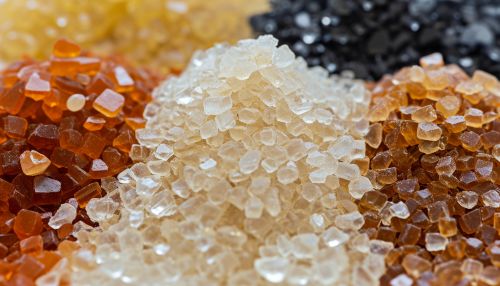Resin
Introduction
Resin is a solid or highly viscous substance of plant or synthetic origin that is typically convertible into polymers. Resins are usually mixtures of organic compounds. This article will delve into the intricate details of resins, their types, properties, uses, and the process of extraction.
Types of Resin
There are several types of resins, both of natural and synthetic origin.
Natural Resins
Natural resins are typically secreted by plants and are usually terpenes or derivatives of terpenes. Some examples include:
- Rosin: This is a solid form of resin obtained from pines and other plants, mostly conifers.
- Amber: This is fossilized resin from ancient evergreen trees.
- Copal: This is a name given to tree resin, particularly the aromatic resins from the copal tree Protium copal (Burseraceae) used by the cultures of pre-Columbian Mesoamerica as ceremonially burned incense and other purposes.
Synthetic Resins
Synthetic resins are materials with properties similar to natural resins—hard, transparent, and brittle solids or liquids. They are different chemically and are divided into several classes:
- Thermosetting Resins: These are polymers that are irreversibly hardened by curing from a soft solid or viscous liquid prepolymer or resin.
- Thermoplastic Resins: These are a type of polymer that becomes pliable or moldable at a certain elevated temperature and solidifies upon cooling.


Properties of Resin
Resins, both natural and synthetic, have a wide range of properties that make them useful in various applications. These properties include:
- Chemical Resistance: Resins are resistant to degradation by a wide range of chemicals.
- Electrical Insulation: They have excellent electrical insulating properties.
- Thermal Stability: Resins can withstand high temperatures without significant degradation.
- Adhesive Properties: They have the ability to stick to a wide range of surfaces.
Uses of Resin
Resins find use in a variety of applications due to their versatile properties. Some of the uses include:
- Adhesive: Resins are used in a variety of adhesives due to their excellent adhesive properties.
- Paint: They are used in paints to provide gloss and durability.
- Varnish: Resins are used in varnishes to provide a protective finish.
- Plastic: They are used in the production of plastics, both as a raw material and as a filler.
- Ink: Resins are used in inks to provide color and consistency.
Extraction of Resin
The extraction of resin from plants involves a process called tapping. This involves making a cut in the tree's bark, after which the resin flows out and is collected. The process is similar to that used for collecting sap for syrup. The resin is then processed to remove impurities and can be used in various applications.
